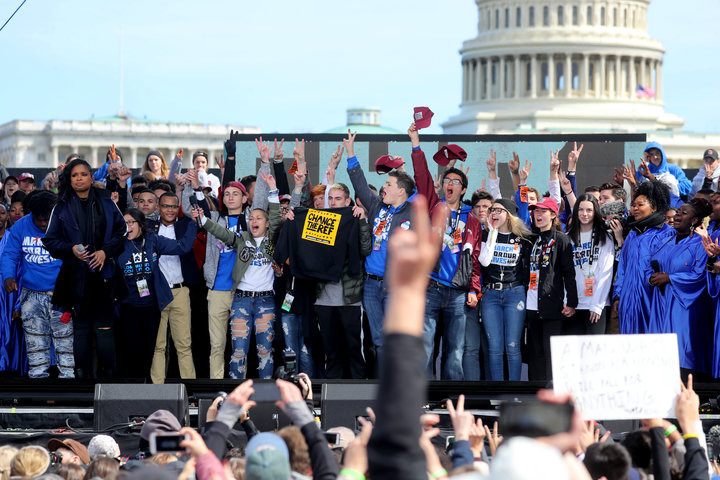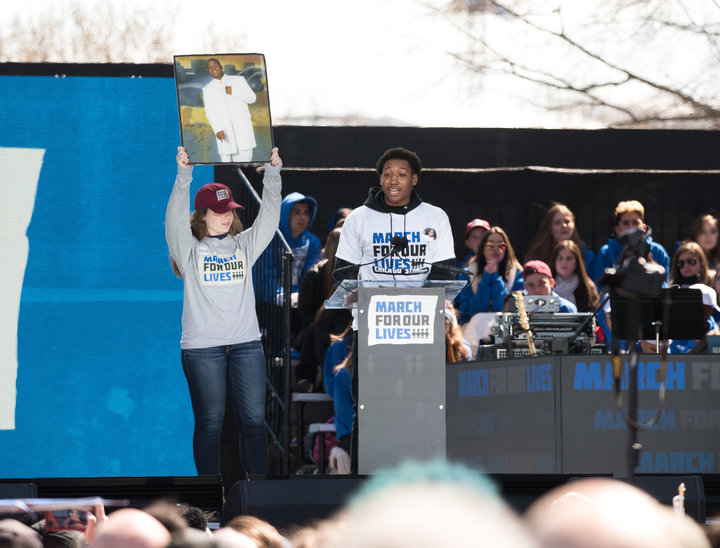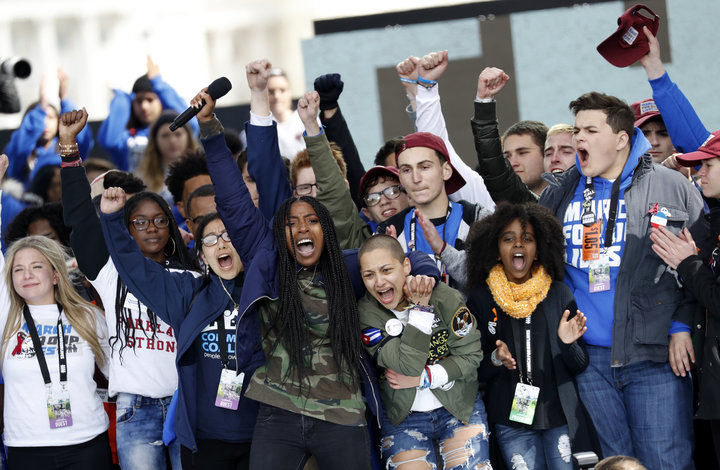[ad_1]
The message at the March for Our Lives rally in Washington this weekend was clear: Gun violence isn’t just a problem of mass shootings like the one at Marjory Stoneman Douglas High School in Parkland, Florida, last month. Nor is it isolated to the bloodshed that tears through cities on a daily basis, or to other routine shootings often tied to mental health, domestic violence or police intervention.
Gun violence is an all of the above issue.
As speakers took the stage on Saturday ― none of them above the age of 19 ― they offered differing perspectives on the many ways guns affect individuals and communities alike.
This diversity shouldn’t have come as a shock to anyone following the Stoneman Douglas students as they prepared for the event. In the lead-up to the rally, they spoke out about their own privilege and the need to broaden their scope beyond the mass shootings that rarely, but explosively, strike affluent communities like theirs. They met with students from Chicago and Washington to discuss what gun violence looks like to them, and how best to confront it.
The lineup of speakers seemed like proof the Parkland students weren’t just talking the talk. They had worked to make their movement genuinely inclusive, both in terms of race and socioeconomic class, and in its embodiment of the varied experiences of gun violence around the nation.
But now comes the hard part for the March for Our Lives movement. As it evolves beyond activism and into more concrete advocacy, the students face the challenge of crafting an agenda that continues to embrace inclusivity while working toward solutions to tackle gun violence in all of its forms.
“Gun violence is such a local issue,” said Paul John, leader of the New York City chapter of Million Hoodies, a racial justice group. “Whereas some communities may have more of an issue with domestic violence, certain suburbs may have been impacted my mass shootings, others by suicide.”
Each of those problems requires a different set of tools to address. When it comes to urban gun violence in particular, which accounts for a disproportionate share of overall shootings, it can be a challenge to get people outside the affected communities to understand how pervasive and deeply intertwined the issue is with other structural inequities that have long plagued inner-city neighborhoods, John said.
“It’s going to be important for the young Parkland students to realize how complex gun violence really is and take steps toward being more informed as to how gun violence affects communities around the country,” he said.

The March For Our Lives campaign has already identified a number of policy objectives, including universal background checks for gun purchases and a ban on assault weapons like the AR-15 style rifle used in Parkland. But to those who have been actively involved in community-based gun violence prevention efforts, prescriptions like these are far from a catch-all.
“We all agree gun laws are a good start, but we really need to look more comprehensively at what it is that causes people to act out violently,” said Miguel Dominguez, director of youth programs at Community Coalition, a social justice nonprofit in Los Angeles.
Lamar Johnson, the violence prevention coordinator for BRAVE (Bold Resistance Against Violence Everywhere), based out of St. Sabina Parish in Chicago, sees it similarly.
“We have legislation and we have tough gun laws, but what we don’t have is investment in our community,” he said.
A decadeslong lack of investment in neighborhoods in Chicago and Los Angeles has helped feed a “culture of violence,” said Johnson. With little funding for schools, businesses and social services, many local kids suffer from a lack of opportunity, which serves as a pipeline into the sorts of criminal activity that often leads to shootings.
Both Community Coalition and BRAVE take a holistic approach to violence prevention, providing outreach to youth to give them the skills and resources they need to resist the traps that can lead them down these roads in the first place.

Youth leaders from both organizations spoke on Saturday to offer a window into the realities they face. Edna Chavez, a 17-year-old from Los Angeles, recalled learning how to “duck from bullets” before she could read. Trevon Bosley, a 19-year-old from Chicago, reminded the crowd that “everyday shootings are everyday problems.” Chavez and Bosley both lost brothers to gun violence.
Johnson said he was happy to see those voices represented at the March for Our Lives, but he noted that initiatives like BRAVE need more than just a larger stage from which to tell their stories.
“People figure they gave us a platform to speak so they did their due diligence, which is like a slap to the face, because giving me a microphone means nothing if you’re not going to give me the funding and the resources for my youth program and violence prevention programs,” said Johnson. “We still have to go back into this crime element we live in every day.”
St. Sabina has seen an uptick in calls from interested donors since Bosley’s speech, said Johnson. But so far, there have been no celebrities or high-dollar donations ― no Oprah, or George and Amal Clooney, who together donated $1 million to the March for Our Lives.
“We’re still pushing for that and we still need that and that’s why we’re trying to publicize it as much as possible to say, it’s not just in Chicago but in all the urban cities across America that have the same issues,” said Johnson.
Johnson added that his BRAVE members have remained in touch with the Parkland students, and that they’ve discussed additional events for the summer, when violence in Chicago and in many cities tends to spike.
The March for Our Lives students will need to continue actively fostering this collaboration if they want to keep their movement truly inclusive, said Amber Goodwin, founder and executive director of Community Justice Reform Coalition, a national advocacy group focused on gun violence prevention. Goodwin said this sort of cooperation will be mutually beneficial.
“Plugging in with groups that are already doing the local work is really important,” she said. “It’s a great way to show partnership, but also to meet people where they’re already at, versus asking people to come to where folks in the gun violence prevention space have been for so long.”
A crucial part of this alliance will involve the Parkland kids simply listening to the concerns of other communities and using their input to inform the movement’s agenda, said Goodwin.
This has to be an intersectional issue.
Amber Goodwin, Community Justice Reform Coalition
Policies can have different effects and connotations for different groups of people, and solutions that appeal to some may seem dangerous to others.
That disparity was on display in Parkland this week, where a group of black Stoneman Douglas students spoke out, explaining that the increased police presence at school since the shooting made them uncomfortable. They also said they felt they’d been left out of conversations about the local response to the massacre.
This sort of oversight has cropped up in the national gun violence prevention movement as well, said Goodwin, who previously worked for the gun control organization launched by former Rep. Gabrielle Giffords (D-Ariz.). She said many groups working on the issue been “siloed,” which has meant marginalized communities have sometimes not had “the self-determination and the space” to be able to advocate for their specific needs.
The March for Our Lives was an all-too-rare example of what it looks like when these communities are given that opportunity, said Goodwin. She advised the Stoneman Douglas students to continue reaching out to elected officials and organizations that center communities of color, and to take advantage of existing local partnerships and gun violence prevention programs that have already shown tangible results.
“This has to be an intersectional issue,” said Goodwin. “But it’s not just a matter of saying that things are not diverse and that we need diversity and inclusion; it’s actually going to be dismantling a lot of the systems that have been built.”
That won’t be an easy task, Goodwin admits, which is one reason she believes the young organizers behind March for Our Lives shouldn’t be afraid to lean on adults for their experience and expertise.
“Yes, young people should lead, but we should be thinking about how we do this inter-generationally, where we’re looking at the strategies that have worked for more seasoned organizers,” she said.

But even if the March for Our Lives students do dedicate themselves to building and strengthening these sort of partnerships, many of the obstacles for local gun violence prevention efforts will remain. Getting the necessary resources and support needed for them to succeed is a constant struggle, said Paul of Million Hoodies.
“Many times, the local governments are strapped for funding to implement these strategies … so being able to bring in private funding and being able to bring in people who are looking to support gun violence prevention organizations on a consistent basis is key,” he said.
With a massive platform, the March for Our Lives organizers may be able to help channel resources toward those initiatives.
Another way the March for Our Lives movement can champion these causes is through the ballot. Organizers made a big push to register voters at the weekend rallies, and the Parkland students have made the November elections a key focal point in the movement.
But activists want young people to know that it’s not just a matter of backing members of Congress who support gun reform. It’s also about mayors, city councilmembers and other local officials who, in some ways, have more direct power to address gun violence in their communities.
Although the Parkland students have a lot of work ahead to ensure that their movement can deliver on the promising vision laid out on Saturday, John is cautiously optimistic that they’ll be able to succeed where others have failed.
“Generation after generation, you see people become at least a little more radical in their thinking of how to change the world,” he said. “These young folks, I think, are much more willing to work together than I’ve seen historically in this movement.”
[ad_2]
Source link

